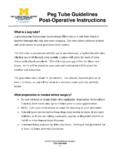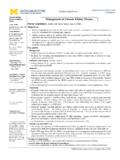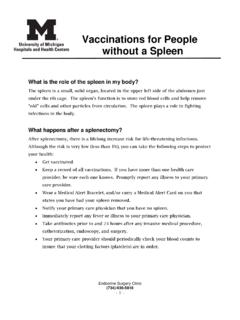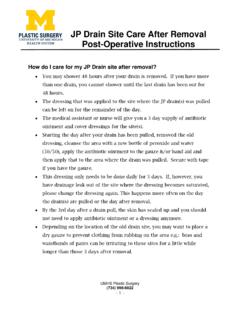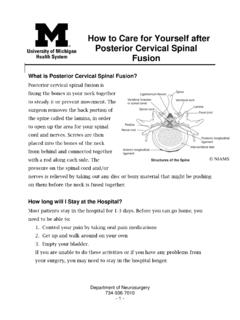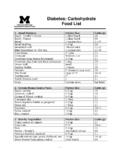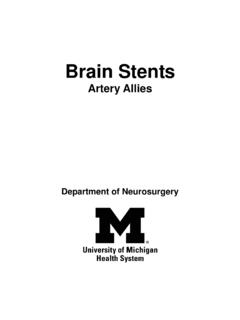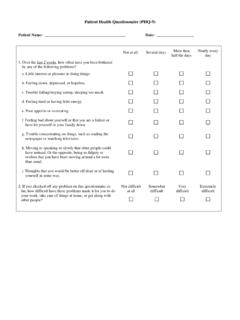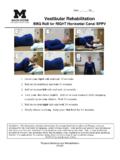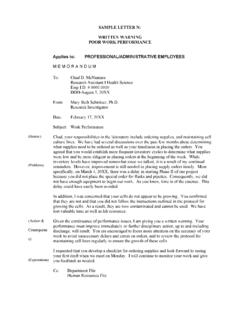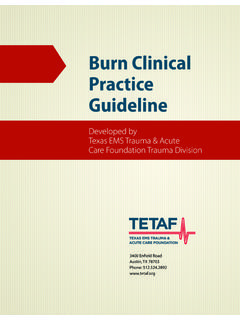Transcription of Urinary Tract Infection - Michigan Medicine
1 1 Quality Department guidelines for Clinical Care Ambulatory Urinary Tract Infection Guideline Team Team Leader Steven E Gradwohl, MD General Medicine Team Members Catherine M Bettcher, MD Family Medicine Carol E Chenoweth, MD Infectious Diseases R Van Harrison, PhD Medical Education Lauren B Zoschnick, MD Obstetrics & Gynecology Initial Release June, 1999 Most Recent Major Update May, 2011 Interim/Minor Revision September, 2016 Ambulatory Clinical guidelines Oversight Grant M Greenberg, MD, MA, MHSA R Van Harrison, PhD Literature search service Taubman Health Sciences Library Urinary Tract Infection Patient population: Adult women with uncomplicated UTI Objective: Implement a cost-effective strategy for uncomplicated UTI in women Key Points Diagnosis History. Diagnosis is made primarily by history. In women with dysuria and frequency, in the absence of vaginitis, the diagnosis is UTI 80% of the time [IC*].
2 Phone triage. In women with prior history of uncomplicated UTI's, consider phone triage [IIC*]. Urinalysis. Urinalysis for detection of pyuria by dipstick or microscope has a sensitivity of 80-90% and a specificity of 50% for predicting UTI [IB*]. No urine culture. Urine culture is NOT indicated in the vast majority of UTI s [IIIC*]. UC has a sensitivity of 50% (if threshold for positive is >105 organisms), sensitivity can be increased to >90% if threshold is >102 organisms. Consider urine culture only in recurrent UTI or in the presence of complicating factors. Treatment First line - Five days of nitrofurantoin [IA*]. Second line -Three days of trimethoprim / sulfa [IA*]. Seven days of 1 cephalosporin or amoxicillin-clavulanic acid [IA*]. Follow-up No tests if asymptomatic. No laboratory follow-up is necessary if asymptomatic [IIIB*].
3 For recurrent UTI s. In patients with recurrent UTI's (>3 / year) consider antibiotic prophylaxis / self-initiated therapy [IIA*] urologic structural evaluation rarely indicated [IIID*] * Strength of recommendation: I = generally should be performed; II = may be reasonable to perform; III = generally should not be performed. Level of evidence supporting a diagnostic method or an intervention: A=randomized controlled trials; B=controlled trials, no randomization; C=observational trials; D=opinion of expert panel. Clinical Background For more information 734-936-9771 Regents of the University of Michigan These guidelines should not be construed as including all proper methods of care or excluding other acceptable methods of care reasonably directed to obtaining the same results. The ultimate judgment regarding any specific clinical procedure or treatment must be made by the physician in light of the circumstances presented by the patient.
4 Clinical Problem and Management Issues Incidence Urinary Tract infections (UTI) are estimated to account for over 7 million office visits per year, at a cost of over $1 billion. Up to 40% of women will develop UTI at least once during their lives, and a significant number of these women will have recurrent Urinary Tract infections . Cost-Effective Strategy Establishing a cost-effective strategy for the diagnosis and treatment of UTI is important because of its high incidence. Laboratory tests should be ordered only when the results are likely to alter the process or outcome of care. Antibiotic treatment should be prescribed only for as long as necessary to be effective. Recurrent UTI s may be managed better by self-initiated therapy or prophylaxis than by continuing to treat each case emergently.
5 This guideline provides an approach to uncomplicated UTI that results in good clinical outcomes and utilizes clinical care resources appropriately. Rationale for Recommendations The rationale for recommendations addresses: Risk factors Complicating factors Uncomplicated UTI Recurrent UTI s Asymptomatic bacteriuria Acute uncomplicated pyelonephritis UTI in pregnancy (Continued on page 3) 2 UMHS Urinary Tract Infection Guideline, September 2016 Figure 1. Diagnosis and Management of UTI in Adult Non-Pregnant Women Adult non-pregnant woman w ith U TI sympto ms telephones officePrevious history of uncomplicated UTI s?Eligible for prescription by phone? (See nursing Protocol) Similar symptom s to prior UTI s Lack of vaginitis symptoms No complicating factors/pyelo symptoms (see Table 2)Empiric treatment (See T able 3)YesSchedule office visitVaginitis sym ptoms?
6 , itching or dischargeNoAsymptomatic after 3 da ys?Follow-up PR NYesNoNoEvaluate for gynecologic pathologyYesUrinalysis microscopic dipstick results Consider: Pelvic exam Urine cultureNoNegativeUTI uncomplicated?Complicating conditions: Complicating factors? (Table 2) See complicating factors section Recurrent UTI s? (>3/year) See recurrent UTI section Pyelo symptoms? See pyelonephritis section Pregnancy? See pregnancy sectionNoPositiveFive days of nitrofurantoin (No urine culture necessary.)YesSymptoms persist? Re-visit Consider:-- Pelvic exam-- Urine culture with sensitivitiesYesFollow-up PR N(No follow-up UA or UC necessary) Table 3. Treatment Regimens and Cost1 Table 4. Management of Recurrent UTI 1. Treat acute UTI (see Table 3). 2. Check follow-up urine culture if necessary to distinguish relapse from recurrence, otherwise generally not necessary.
7 3. Educate. Counsel about risk factors: consider alternative to use of spermicide consider vaginal estrogen in postmenopausal women 4. Prophylaxis. Consider: continuous or postcoital antibiotic (trimethoprim / sulfa SS 80/400 daily or nitrofurantoin 50-100 mg at bedtime) self initiated therapy (Table 3) 5. Structural evaluation is generally not indicated. First Line: Nitrofurantoin2 100 mg BID x 5 days Second Line: Trimethoprim/Sulfa DS BID x 3days Cephalexin 500 mg BID x 7 days Amoxicillin-clavulanic acid 875-125 mg x 7 days Fosfomycin 3 gm x 1 dose Brand Generic $32 $17 $17 $5 $130 $28 $7 $5 $70 n/a 1 Cost = Average wholesale price based -10% for brand products and Maximum Allowable Cost (MAC) + $3 for generics, from Red Book Online, 9/2016, and Michigan Department of Community Health Manager, 9/2016. 2 Nitrofurantoin should not be used with creatinine clearance less than 50 ml/minTable 1.
8 Laboratory Charges (M-Labs) Urinalysis - dipstick $27 Urinalysis - microscopic (complete) $27 Urine culture $35 Table 2. Complicating Factors Diabetes Mellitus Immunosuppression Urologic Structural / Functional Abnormality Nephrolithiasis present Recent Hospitalization / Nursing home Catheter Symptoms for > 7 days 3 UMHS Urinary Tract Infection Guideline, September 2016 Rationale for Recommendations (continued) Risk Factors The majority of UTI's occur in sexually active women. Risk increases by 3-5 times when diaphragms are used for contraception. Risk also increases slightly with not voiding after sexual intercourse and use of spermicide. Increased risk has not been demonstrated with oral contraceptives, not voiding before intercourse, non-cotton underwear, and use of condoms. Microbial Etiology Escherichia coli is the predominant pathogen in uncomplicated UTI in women, associated with more than 80% of cases.
9 Staphylococcus saprophyticus is found in 15% of cases. Other members of the Enterobacteriaceae family, such as Klebsiella sp., Proteus sp., or Enterobacter sp. are associated with uncomplicated UTI. Group B streptococci are an uncommon pathogen in UTI in young healthy women, but requires treatment in pregnant women. Complicating Factors and Medical Conditions Patients with complicating factors and medical conditions are at increased risk of development of pyelonephritis or Infection with resistant organisms. Complicating factors are listed in Table 2 and include underlying urologic structural abnormalities, diabetes, immunosuppression, pregnancy, recent hospitalization, or urologic Tract manipulation. It is necessary to differentiate these women from those with uncomplicated UTI in terms of both work-up and treatment.
10 Unlike women with uncomplicated UTI, care for women with complicating factors may include: Culture. Obtain pretreatment culture and sensitivity. Treatment. Initiate treatment with nitrofurantoin or fosfomycin for 7-14 days; longer durations, 10-14 days are recommended if delayed response to treatment. Fluoroquinolones are contraindicated in pregnancy. Fluoroquinolones should be used only if there is a contraindication to trimethoprim/sulfa as they have been shown to have high rates of E coli resistance and propensity for collateral damage (resistance, C difficile Infection , tendinopathy). Follow-up UA. Obtain follow-up urinalysis to document clearing. Possible structural evaluation. Lower threshold for urologic structural evaluation with cysto / IVP. Uncomplicated UTI Diagnosis.
